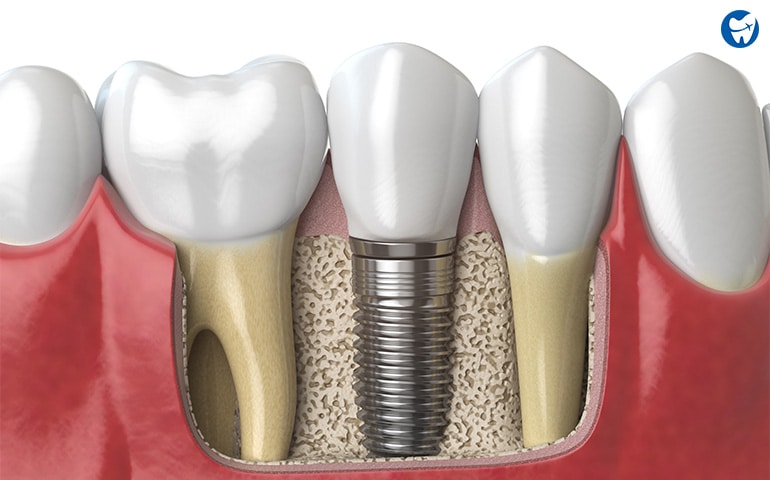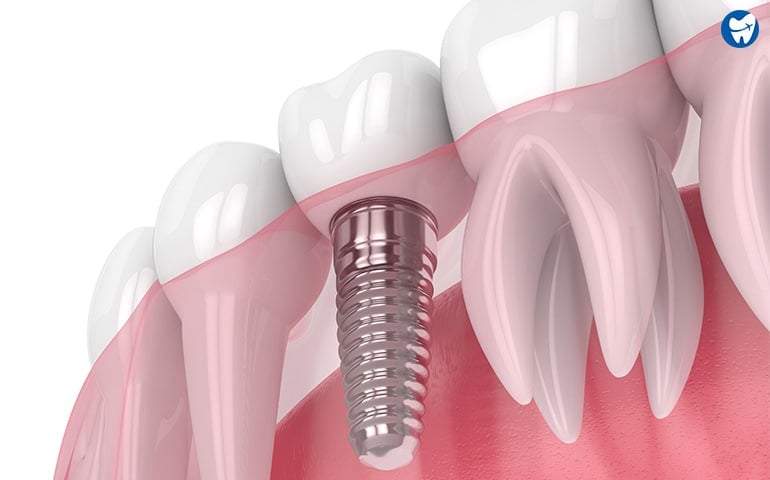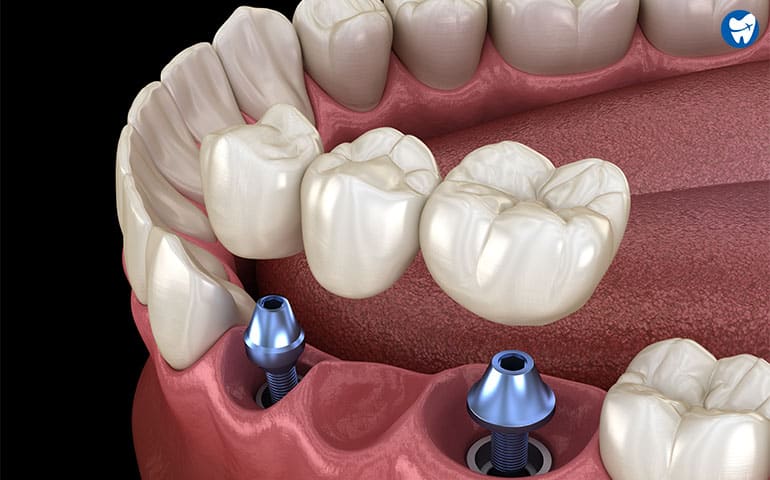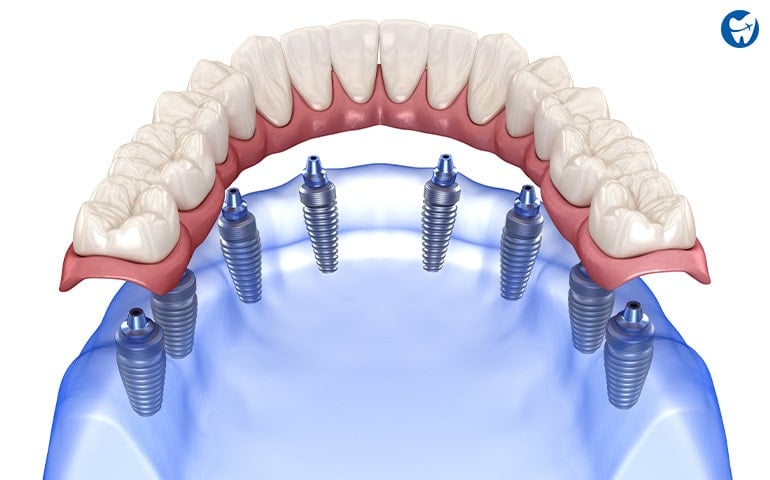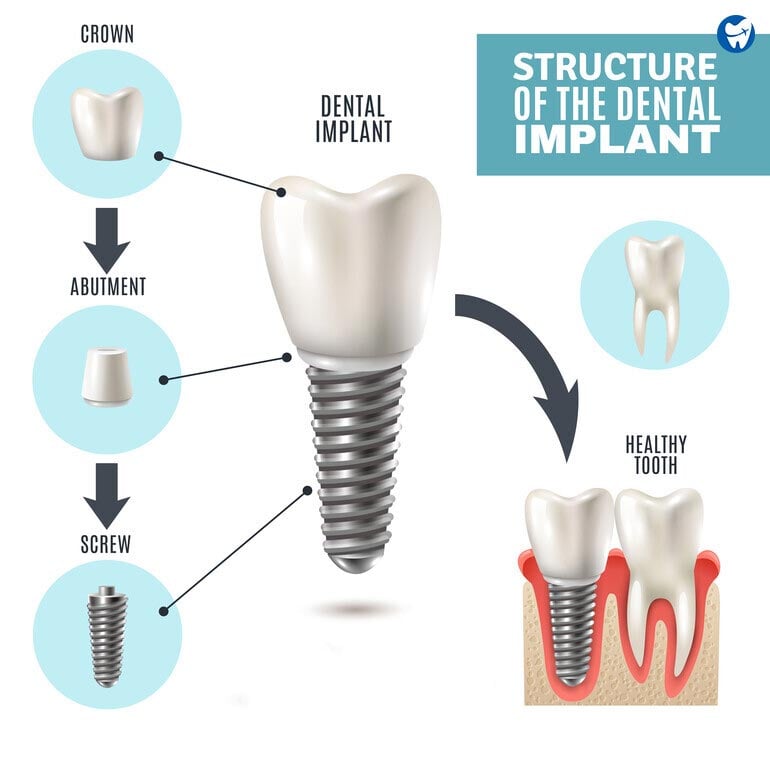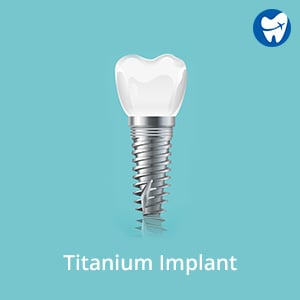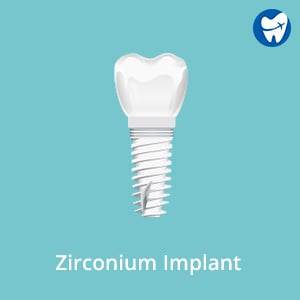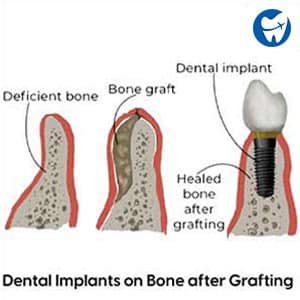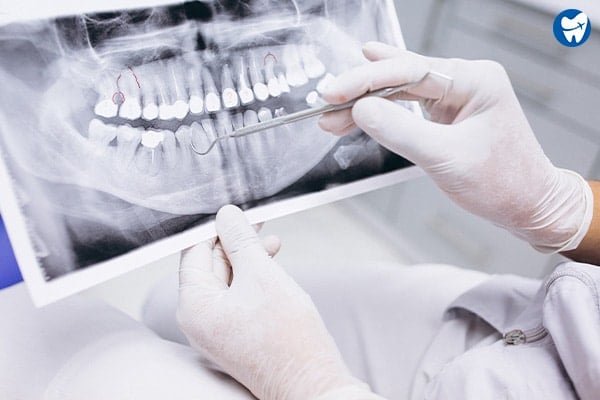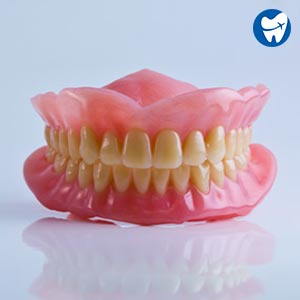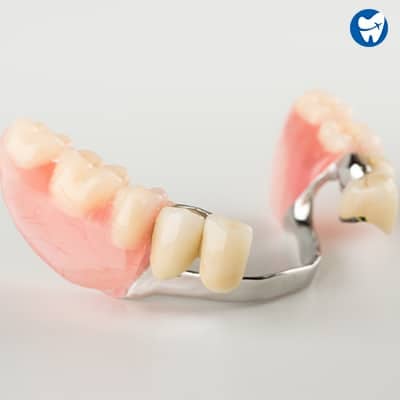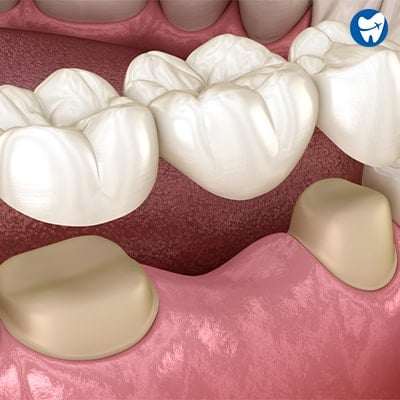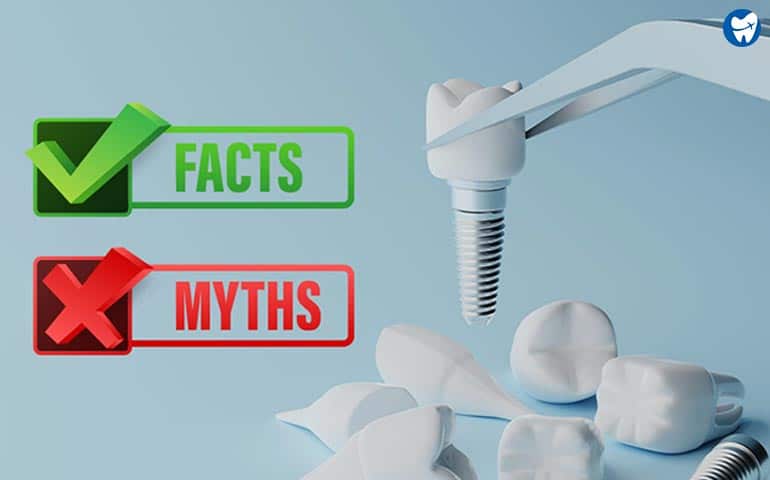Lost & decayed teeth make eating difficult and reduce your confidence to smile or talk in your social circle. Conventional treatments such as fixed and removable dentures are uncomfortable and don’t feel natural.
Guess what? You don’t have to get inferior treatment. Dental implants are a permanent and esthetic solution to your tooth replacement needs.
Video courtesy: Gebrüder Betz Medical Animation
Dental care is an important component of overall health. Despite this, data from developed countries show shocking statistics.
- In the USA, adults aged 20-64 years have three or more decayed or missing teeth. [1]
- In Australia, one in 3 adults aged 15 and above have at least one tooth affected by dental caries. [2]
- In Canada, 97.7% of the adolescent population is affected by dental caries.
- 31% of adults have tooth decay in the UK, and 74% have had a tooth extracted. [3]
What Are Dental Implants?
A dental implant is a metal (titanium or zirconium) screw-like component placed in the jaw bone to replace the missing root.
Unlike a fixed or removable bridge, dental implants do not harm the surrounding teeth and soft tissues.
You will find a dental implant gives the most natural feel to your mouth.
Dental Implants
What Is the Cost of Dental Implants?
A full set of high-quality dental implants costs from USD 15,000 to 90,000 depending on your location, implant material, and the dentist’s expertise.
A single titanium implant will cost anywhere between USD 1,000 to 5,000 in America.
Cost of Dental Implants in the US (USD)
| Type | Without Insurance | With Insurance |
| Single implant | $1000 – 5000 | 50% of dental implant cost (may vary)* |
| Full set (All on 4/6/8) | $15,000 – 90,000 |
*Hiossen.com [4]
Unaffordable dental care back home? Worry not!
Call us nowWhat Makes Dental Implants Significant For Patients?
Dental implants are the most popular choice for a missing tooth.
According to the American Academy of Implant Dentistry, 500,000 new dental implants are placed every year in the USA. [5]
The benefits of dental implants do not merely include replacing a missing tooth but also maintaining the jaw bone height and the ability to smile confidently.
Dental implants raise the quality of life [6] by improving the chewing capacity.
What Are the Techniques of Dental Implants?
Dental implants are placed singly or for multiple teeth. Based on the number of teeth replaced, they are categorized as Single tooth implants and Full-mouth Implants.
A single implant is the most commonly used restoration technique for a
- single missing tooth or
- multiple missing teeth not adjacent to each other.
Single Tooth Implant
It is recommended for front tooth replacement.
A single tooth implant offers the advantage of natural aesthetics without damaging nieghbouring teeth.
An implant support bridge is useful when you have multiple missing teeth situated adjacent to each other.
Dental Bridge
To understand better, let’s say you have three missing teeth next to each other.
Your dentist will place two implants at each end and create a three-crown bridge to be attached to the implants.
As in the case of single tooth implants, no support is required from adjacent natural teeth.
In this case, four (or more) dental implants are strategically placed on either side of the arch.
A custom-made denture is then made and fixed over these implants to imitate natural dentition.
Full Mouth Implants
Such a denture is called an All-on-4 dental implant. It is a secure and permanent solution for your improved aesthetic and confidence.
If most of your teeth are missing and you are looking for full mouth reconstruction, this option is for you!
In some cases, the denture is supported with 6 or 8 dental implants. Such dentures are called all on 6 or all on 8. It usually happens in the upper jaw, where the bone is less dense than the lower jaw.
What Are the Types of Dental Implants?
There are 3 main types of dental implants: Endosteal, subperiosteal, and zygomatic dental implants. Each type is used in certain cases and conditions.
- Endosteal dental implants: The most common type. Patients with healthy jawbones or those who can receive a bone graft are eligible for these.
- Subperiosteal dental implants: Patients who don’t have enough jawbone and are uncomfortable with going through a bone graft surgery choose this option.
- Zygomatic dental implants: Zygomatic dental implants are a solution for patients who don’t qualify for endosteal implants. The implant is embedded in the cheekbone.
What Are the Parts of Dental Implants?
A dental implant has three parts – the fixture, the abutment, and the artificial tooth.
Fixture or Screw
A fixture is commonly known as an implant, implant body, or post. It is the part that is placed surgically in the bone where the tooth root used to be.
It is covered by the gums and stitched in place to allow osseointegration.
If you have never seen an implant, imagine a screw, and you know what an implant body looks like! Cylindrical and tapering towards one end to mimic natural roots.
Abutment
Since the fixture is entirely inside the gums, abutment acts as a component that connects the implant to the crown.
An abutment is a short and stumpy part, one end of which is designed to fit inside the implant post, while the other side is designed to adhere to the crown.
The crown side of the abutment extends above the gums to receive the crown.
The dentist may choose to place the abutment along with the implant or wait for the bone-implant fusion. If done after fusion, the gum is opened again to attach the abutment to the implant.
Crown or Artificial Tooth
The visible part of a dental implant is called a crown or, more appropriately, a dental prosthesis.
We prefer to call it a dental prosthesis because it can be a single crown, a bridge, or a complete denture depending upon the number of teeth to be replaced.
The crown is made out of porcelain or ceramic, making it look and work like a natural tooth.
What Materials Are Used as Dental Implants?
Dental implants are most commonly made from Titanium.
Another less commonly used metal is Zirconia. Both are the best dental implant materials known today.
Why Are Dental Implants Made From Titanium and Zirconia?
Titanium is the gold standard for making dental implants. It is a popular material because of many reasons:
- Titanium is biocompatible with the bone and gums
- It is corrosion resistant
- It has a high strength to tolerate the chewing force
- It does not bend easily under stress
Source: MDPI [7]
Zirconia (Zirconium dioxide) has recently been introduced in dentistry. It has the following advantages:
- Its naturally white color mimics the natural tooth material.
- It is bio-inert and biocompatible.
- It has high-strength and corrosion-resistance properties
- It is extremely smooth and prevents plaque buildup.
Source: Periodontology 2000 [8]
Which Dental Implant Should I Go For – Titanium or Zirconia?
| Properties | Zirconia | Titanium |
|---|---|---|
| Colour | White, opaque | Grey, shiny |
| Aesthetics | High | Less esthetic in front teeth [9] |
| Strength | High | High |
| Biocompatibility | Very high | High |
| Allergic reaction | Not seen | Rare cases of allergic reaction [10] |
| Experience with metal | Less. | Extensive |
| Susceptibility to plaque biofilm | No | Yes [11] |
| Long-term success rate | Short-term studies show a 92% success rate at one year. [12] | 94-97% success rate |
| Cost | Roughly $300 higher than titanium implants | $1,000-$5,000 per implant |
What Are the Things Which Matter When You Go For Dental Implants?
Some of the very first things that the dentist will look for include:
- The health of your teeth and gums
- Number of teeth to be replaced
- Which teeth to replace
- If you need any extractions
- Grafting requirement for jawbone
Bone grafting is done when your jawbone is thin or lacks the required height.
A strong jawbone is essential for this dental replacement because chewing generates heavy forces.
Bone grafts can be natural – taken from another location of your body or synthetic.
You can discuss your options with your dentist.
You can discuss your options with your dentist. Depending on the above findings, the whole procedure can take from a few hours to a year.
Your dentist will give a clear idea of the duration.
What is the Procedure to Place Dental Implants?
Steps for placing dental implants:
Consultation and Treatment Plan
As with anything else, you will consult your dentist for the best course of action.
The dentist will take X-Rays and dental impressions of your teeth. X-rays help to know the health of the jawbone, which will support the implants.
Medical history is also important at this point.
If you have the following conditions, dental implants are partially contraindicated (varies from case to case) for you. [13]
- A recent incident of heart attack or stroke
- Chronic smoking
- Artificial heart valve
- Immune system suppression
- Bleeding disorders
- Active cancer treatment
- Psychiatric illness
- Drug abuse
- Osteoporosis (weak bones)
- IV bisphosphonates (treatment for osteoporosis)
Your dentist may need to collaborate with your physician in the above cases.
Dental Implant Procedure
Video Courtesy: Manatee advanced dentistry
Dental Implant Placement
- The gums are cut in an outpatient surgical procedure to expose the bone.
- The dentist then drills holes in the jawbone to place implant posts
- A dental implant is placed deep in the bone.
- The gums are stitched
The dental implant fuses to the bone over six to twelve weeks. The process is called osseointegration (Osseo – bone; integration – combine).
This period is a little lengthy and associated with mild pain or soreness.
Abutment Placement
After the bone-implant bond is confirmed with an X-ray, an abutment is attached to the new dental implant so that only a small part of it is visible in the mouth.
It is a minor surgical procedure done in an outpatient setting. The gums will take approximately two weeks to heal for the next step.
Artificial Tooth Placement
After the gums heal, the dentist will take an impression of your teeth. This is done to understand the size and arrangement of your teeth.
The new teeth have to match the existing teeth to give a natural look. The new crown (or bridge or denture) is constructed and placed over the abutment.
The crown is also color-matched to your other teeth to add to your natural look. The new prosthesis can be:
- Removable – fixes on abutment through a snap-in movement
- Fixed - screwed or cemented on the abutment
Will I Experience Pain and Swelling After Dental Implant Procedures?
The human body will always react to surgery, but studies show that pain is usually mild. [14]
After each procedure, you may experience:
- Swelling on the face and gums
- Pain at and around the implant site
- Bruising of gums and cheeks
- Minor bleeding
Your dentist will guide you during this period which may include one or more of the following: painkillers, antibiotics, soft foods to eat, stop smoking, avoid the use of straw and stop spitting.
How Will I Care For My New Implants?
You must take care of your implants like your natural teeth. You have to brush, floss, use antibiotic mouthwash and get timely dental check-ups.
Who Can Place a Dental Implant?
The dentist’s experience, education, and skill will decide the long-term effectiveness of your dental implants.
All countries provide certification to their dentists who are capable and qualified to place an implant.
These dentists invest in rigorous implant-focused training and are most suitable to offer you guidance.
To ensure that you receive adequate treatment, ask your dentist during the initial consultation if they are a certified implant specialist.
What Are the Benefits and Risks of Having Dental Implants?
Getting an implant is a life-long commitment and a costly affair. You must be wondering about the pros and cons of tooth replacement with dental implants.
- Long-term treatment option
- Closely mimics natural dentition (a root and a crown)
- Prevents bone loss
- Beautiful aesthetics
- Improved confidence
- High success rate
- Injury to adjacent anatomical structures
- Allergy to titanium (some cases)
- Injury to surrounding nerves, blood vessels & teeth [15]
- Implant fracture
- Infection at the implant site
What Are Some Alternatives to Dental Implants?
Alternatives to dental implants include Full mouth dentures, Removable partial dentures, fixed partial dentures, or bridge. [16]
Full Mouth Dentures
This is a common type of dental replacement.
In this, artificial teeth are aligned in tissue-colored material to replace all missing teeth.
They perform better than damaged teeth or no teeth.
But dentures do not function as well as dental implants.
Complete denture
Removable Partial Dentures
When a few teeth are missing, fake teeth are attached to a gum-colored base to blend in with your other teeth.
The base usually covers a metal frame and may have metal extensions (clasps) to take support from your adjacent teeth.
Removable Partial Dentures
Fixed Bridges
These partial dentures are fixed using a bonding material, so they are not removable.
They don’t carry the risk of becoming loose in your mouth, making them a comfortable option.
Fixed Bridge
While these are less costly and less invasive, they lack features found in implants:
| Features | Full Mouth Dentures | Removable Partial Denture | Fixed Partial Denture or Bridge | Dental Implants |
|---|---|---|---|---|
| Stability | Less | Less | Good | Good |
| Damage to surrounding teeth | No | May be | Yes | No |
| Bone preservation | No | No | No | Yes |
| Needs adjustments and replacements | Yes | Yes | Yes | No |
| Life-span | 5-10 years [17] | 5-10 years | 5-15 years [18] | >20 years* [19] |
| Boosts facial appearance | No | No | No | Yes |
*Dental Implants are recent advancements. Studies with more than 20 years of data are currently unavailable.
Myths and Facts About Dental Implants
Myth 1 – Dental Implants are too expensive.
Fact – The upfront cost of dental implants may indeed feel overwhelming. But in the long run, dental implants prove to be
✅ cost-effective and
✅ even cost-saving.
For a single tooth replacement, a dental implant is more cost-effective than a fixed partial denture.
For multiple dental replacements, the high initial cost is overshadowed [20] by several long-term factors:
- Better quality of life
- No worries about changing the dentures every 5 to 15 years
- No added expenses of adhesives and special denture cleansers
- A more natural look
- No damage to adjacent teeth
- Higher patient acceptance
- Higher satisfaction with treatment
Myth 2 – Dental implants are dangerous.
Fact – A small risk is associated with all oral surgeries, but life-threatening risks from dental implants are rare. The recorded failure cases range from only 1-2%. [21]
If you want to be sure, you can take the following steps to maximize benefits from implants:
- Undergo a medical check-up before opting for implants
- Only get implants from a certified dentist [22]
- Maintain thorough dental hygiene. Brush twice, floss and mouthwash
- Eat calcium-rich foods such as milk, cheese, and kale
- Stay away from smoking. Not only does smoking lead to implant failure, but it is also an established cause of oral cancer
- Visit your dentist twice a year
Myth 3 – Everyone will know I have fake teeth.
Fact – Have you fallen prey to this myth? If dentures look so out-of-place and unnatural, so must dental implants!
Well! That’s not at all true. Dental implants give a natural look to your smile because the teeth are color, shape, and size-matched.
Not just that, they sit on the gums just like natural teeth. The gums cover the crown from all sides like your natural teeth so that no one can suspect fake teeth.
According to a study, high patient satisfaction and the acceptable aesthetic outcome were noted 8 to 12 years after treatment with dental implants. [23]
Myth 4 – Dental implants are a quick treatment option.
Fact – Ok! So, you need to be careful with over-enthusiastic advertising.
While dental implants are placed in a single day, it is only one part of the process.
The complete treatment may take days to years, depending on the condition of the jaw and teeth to be replaced.
Your dentist will evaluate your dental condition and tell you the accurate time frame.
Myth 5 – Dental Implants are for old/young people.
Fact – The truth is that placement of dental implants does not depend on age.
Factors such as general health and dental health determine your suitability for implants.
Myth 6 – Dental implants are placed immediately after extraction.
Fact – That’s not true! The time after extraction does not matter.
You can consult for implants years after extraction. The factor that matters here is the height and health of the jaw bone.
It might be interesting to know that the bone height starts decreasing after we lose our teeth.
This is because teeth act as stimulants for bone maintenance.
When implants are placed, they act as stimulants like natural teeth, improving bone health.
Conclusion
Dental implants are the most popular choice of tooth replacement in the developed world.
While they may feel expensive initially, the return on investment is more than satisfactory among patients.
Not only do implants make you feel more natural and confident, they help preserve the health of your jaw bone. No other dental replacement treatment does this.
FAQs
A single dental implant costs from $1000-$5000 in the US. Basic dental insurance plans do not cover dental implant procedures usually because it is considered a cosmetic procedure.
Your insurance plan may cover parts of treatment like – 80% of tooth extraction expenditure, 100% cost of tests, and 50% of dental implant cost.
All of these are essential steps in a dental implant procedure. So, you should talk to your insurance company to understand how much coverage they provide.
A full set of dental implants can cost anywhere between $15,000 and $90,000 in America.
As you know now, dental implants are cosmetic procedures. Typically, basic dental insurance does not cover it. But parts of the treatment may be covered by insurance plans.
You may get 80% coverage for tooth extraction, 100% for testing costs, and 50% for dental implants.
You must talk to your insurance provider to understand the cost of the dental implant procedure.
Some of the factors that decide the cost of dental implants include:
- Type of implant placed – Single-stage implant procedure costs less than the 2-stage procedure. [24]
- The number of implants required – More the implants required, the more the cost.
- Location of implant clinic– Higher cost of living means higher treatment price.
- Skill and experience of the dentist.
- Choice of material – Titanium or Zirconia. Zirconia is on average $300 more expensive than titanium (per tooth).
- Requirement of additional procedures – Bone grafting or socket preservation before implant placement increases the effort and cost of the procedure.
Dental implant placement requires accuracy and skill, for which extensive training is required. Additionally, procedural expenses such as the need for an anesthesiologist and material expenses are high.
But, in the long run, dental implants prove to be more cost-effective than removable and fixed dentures.
No, dentists usually offer easy installment plans. You will be able to spread your expenses over months or years. You can consider going abroad for cheap and high-quality dental implant treatment.
Traveling overseas for dental work is considered cost-effective even after including the cost of travel and accommodation.
Insurance companies consider dental implant procedures to be cosmetic. Traditionally, they do not cover implants, but some related procedures, such as X-rays and extractions, are covered.
But looking at the popularity of implants, some insurance providers have developed insurance schemes that cover dental implants.
If you are in the USA, you can check these out:
- Delta Dental Insurance (www.deltadental.com)
- Spirit Dental and Vision (www.spiritdental.com)
- Ameritas (www.ameritas.com)
- Denali Dental (www.denalidental.com)
The premiums and availability in different states vary, so be sure to check them thoroughly.
Alternatively, you can talk to your dentist about dental discount plans under which you pay a yearly or monthly fee in exchange for reductions on all dental procedures.
This arrangement is between you and your dentist. So, paperwork and wait times are not an issue.
Besides, you can also consider going abroad for dental implant work. Dental tourists usually enjoy 50-70% savings on dental procedures performed abroad.
Placing dental implants requires surgical procedures to be undertaken.
Provided you have chosen a competent dentist, you may experience some pain and swelling on your gums and face. There is nothing to worry about.
Your dentist will guide you during this period which may include one or more of the following:
- Pain-killers
- Antibiotics
- Soft foods to eat
The upper jaw (or maxilla) is a soft bone requiring at least four implants. If the height of the upper jaw is less or the bone is extra thin, eight implants may be needed to support implant denture.
The lower jaw is dense and compact. Some cases can work with as low as two implants. As with everything else, each case is unique.
Pain is a subjective feeling, so there is no black-and-white answer here. In general, the patients experience less pain after implant procedure than they do after extraction.
You should note that pain does not occur during the procedure-either extraction or implant placement. It occurs after the effect of anesthesia is over.
